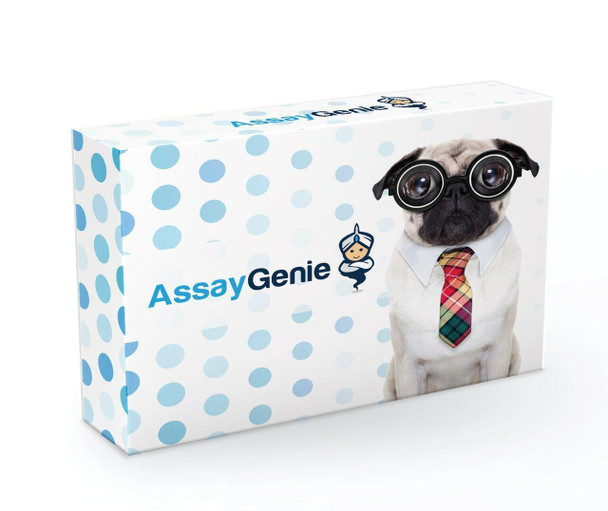Anti-TWIST2 Antibody (CAB5599)
- SKU:
- CAB5599
- Product type:
- Antibody
- Reactivity:
- Human
- Host Species:
- Rabbit
- Isotype:
- IgG
- Antibody Type:
- Polyclonal Antibody
- Research Area:
- Developmental Biology
Description
| Antibody Name: | Anti-TWIST2 Antibody |
| Antibody SKU: | CAB5599 |
| Antibody Size: | 20uL, 50uL, 100uL |
| Application: | WB |
| Reactivity: | Human |
| Host Species: | Rabbit |
| Immunogen: | Recombinant fusion protein containing a sequence corresponding to amino acids 1-70 of human TWIST2 (NP_476527.1). |
| Application: | WB |
| Recommended Dilution: | WB 1:500 - 1:2000 |
| Reactivity: | Human |
| Positive Samples: |
| Immunogen: | Recombinant fusion protein containing a sequence corresponding to amino acids 1-70 of human TWIST2 (NP_476527.1). |
| Purification Method: | Affinity purification |
| Storage Buffer: | Store at -20°C. Avoid freeze / thaw cycles. Buffer: PBS with 0.02% sodium azide, 50% glycerol, pH7.3. |
| Isotype: | IgG |
| Sequence: | MEEG SSSP VSPV DSLG TSEE ELER QPKR FGRK RRYS KKSS EDGS PTPG KRGK KGSP SAQS FEEL QSQR IL |
| Gene ID: | 117581 |
| Uniprot: | Q8WVJ9 |
| Cellular Location: | Cytoplasm, Nucleus |
| Calculated MW: | 18kDa |
| Observed MW: | Refer to figures |
| Synonyms: | TWIST2, AMS, BBRSAY, DERMO1, FFDD3, SETLSS, bHLHa39 |
| Background: | The protein encoded by this gene is a basic helix-loop-helix type transcription factor and shares similarity with Twist. This protein may inhibit osteoblast maturation and maintain cells in a preosteoblast phenotype during osteoblast development. This gene may be upregulated in certain cancers. Mutations in this gene cause focal facial dermal dysplasia 3, Setleis type. Two transcript variants encoding the same protein have been found. |
| UniProt Protein Function: | TWIST2: Binds to the E-box consensus sequence 5'-CANNTG-3' as a heterodimer and inhibits transcriptional activation by MYOD1, MYOG, MEF2A and MEF2C. Also represses expression of proinflammatory cytokines such as TNFA and IL1B. Involved in postnatal glycogen storage and energy metabolism. Inhibits the premature or ectopic differentiation of preosteoblast cells during osteogenesis, possibly by changing the internal signal transduction response of osteoblasts to external growth factors. Defects in TWIST2 are the cause of Setleis syndrome (SETLEISS). A focal facial dermal dysplasia characterized by distinctive bitemporal scar-like depressions resembling forceps marks, and additional facial features, including a coarse and leonine appearance, absent eyelashes on both lids or multiple rows on the upper lids, absent Meibomian glands, slanted eyebrows, chin clefting, and hypo- or hyperpigmentation of the skin. Histologically, the bitemporal lesion is an ectodermal dysplasia with near absence of subcutaneous fat, suggesting insufficient migration of neural crest cells into the frontonasal process and the first branchial arch. |
| UniProt Protein Details: | Chromosomal Location of Human Ortholog: 2q37.3 Cellular Component: cytoplasm; nucleus; transcription factor complex Molecular Function:chromatin binding; DNA binding; protein binding; protein dimerization activity; protein domain specific binding; transcription factor activity Biological Process: embryonic cranial skeleton morphogenesis; negative regulation of apoptosis; negative regulation of cell proliferation; negative regulation of DNA binding; negative regulation of myeloid cell differentiation; negative regulation of osteoblast differentiation; negative regulation of transcription from RNA polymerase II promoter; negative regulation of transcription, DNA-dependent; negative regulation of tumor necrosis factor production; osteoblast differentiation; transcription, DNA-dependent Disease: Ablepharon-macrostomia Syndrome; Barber-say Syndrome; Focal Facial Dermal Dysplasia 3, Setleis Type |
| NCBI Summary: | The protein encoded by this gene is a basic helix-loop-helix type transcription factor and shares similarity with Twist. This protein may inhibit osteoblast maturation and maintain cells in a preosteoblast phenotype during osteoblast development. This gene may be upregulated in certain cancers. Mutations in this gene cause focal facial dermal dysplasia 3, Setleis type. Two transcript variants encoding the same protein have been found. [provided by RefSeq, Apr 2014] |
| UniProt Code: | Q8WVJ9 |
| NCBI GenInfo Identifier: | 429325228 |
| NCBI Gene ID: | 117581 |
| NCBI Accession: | NP_001258822.1 |
| UniProt Secondary Accession: | Q8WVJ9,Q3SYL6, |
| UniProt Related Accession: | Q8WVJ9 |
| Molecular Weight: | 18,124 Da |
| NCBI Full Name: | twist-related protein 2 |
| NCBI Synonym Full Names: | twist family bHLH transcription factor 2 |
| NCBI Official Symbol: | TWIST2 |
| NCBI Official Synonym Symbols: | AMS; FFDD3; BBRSAY; DERMO1; SETLSS; bHLHa39 |
| NCBI Protein Information: | twist-related protein 2 |
| UniProt Protein Name: | Twist-related protein 2 |
| UniProt Synonym Protein Names: | Class A basic helix-loop-helix protein 39; bHLHa39; Dermis-expressed protein 1; Dermo-1 |
| Protein Family: | Twist-related protein |
| UniProt Gene Name: | TWIST2 |
| UniProt Entry Name: | TWST2_HUMAN |

